2015 Hyundai Elantra sensor
[x] Cancel search: sensorPage 10 of 498
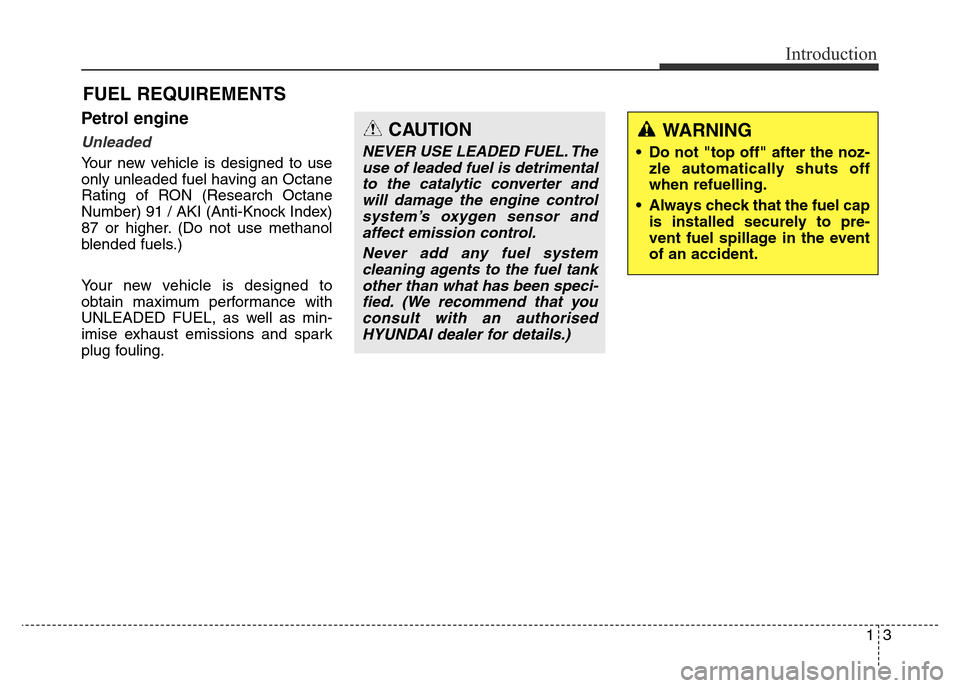
13
Introduction
Petrol engine
Unleaded
Your new vehicle is designed to use
only unleaded fuel having an Octane
Rating of RON (Research Octane
Number) 91 / AKI (Anti-Knock Index)
87 or higher. (Do not use methanol
blended fuels.)
Your new vehicle is designed to
obtain maximum performance with
UNLEADED FUEL, as well as min-
imise exhaust emissions and spark
plug fouling.
FUEL REQUIREMENTS
CAUTION
NEVER USE LEADED FUEL. The
use of leaded fuel is detrimental
to the catalytic converter and
will damage the engine control
system’s oxygen sensor and
affect emission control.
Never add any fuel system
cleaning agents to the fuel tank
other than what has been speci-
fied. (We recommend that you
consult with an authorised
HYUNDAI dealer for details.)
WARNING
• Do not "top off" after the noz-
zle automatically shuts off
when refuelling.
• Always check that the fuel cap
is installed securely to pre-
vent fuel spillage in the event
of an accident.
Page 45 of 498
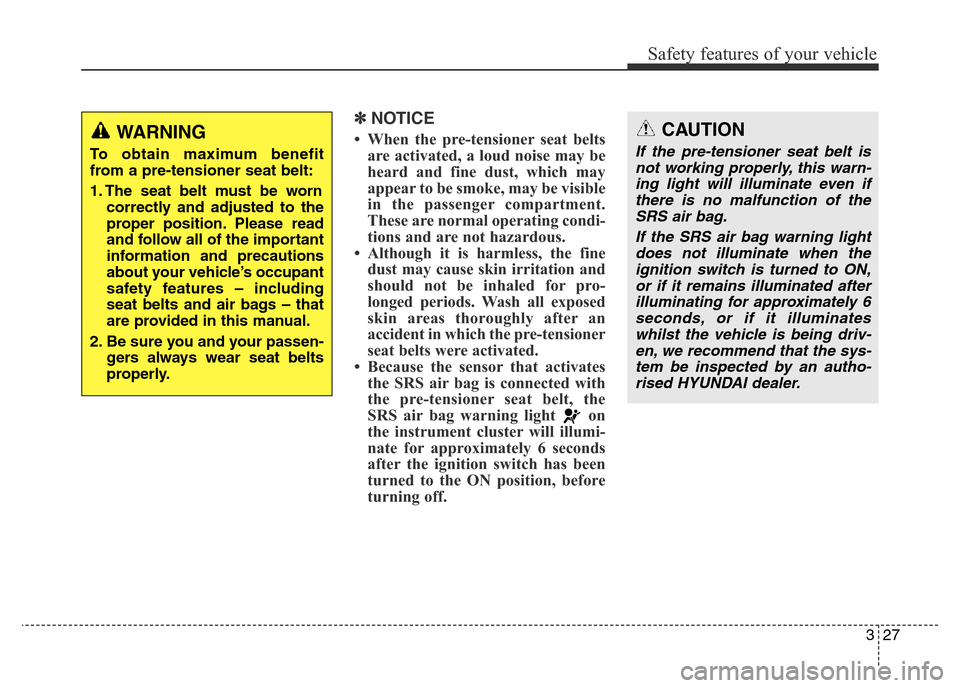
327
Safety features of your vehicle
✽NOTICE
• When the pre-tensioner seat belts
are activated, a loud noise may be
heard and fine dust, which may
appear to be smoke, may be visible
in the passenger compartment.
These are normal operating condi-
tions and are not hazardous.
• Although it is harmless, the fine
dust may cause skin irritation and
should not be inhaled for pro-
longed periods. Wash all exposed
skin areas thoroughly after an
accident in which the pre-tensioner
seat belts were activated.
• Because the sensor that activates
the SRS air bag is connected with
the pre-tensioner seat belt, the
SRS air bag warning light on
the instrument cluster will illumi-
nate for approximately 6 seconds
after the ignition switch has been
turned to the ON position, before
turning off.WARNING
To obtain maximum benefit
from a pre-tensioner seat belt:
1. The seat belt must be worn
correctly and adjusted to the
proper position. Please read
and follow all of the important
information and precautions
about your vehicle’s occupant
safety features – including
seat belts and air bags – that
are provided in this manual.
2. Be sure you and your passen-
gers always wear seat belts
properly.
CAUTION
If the pre-tensioner seat belt is
not working properly, this warn-
ing light will illuminate even if
there is no malfunction of the
SRS air bag.
If the SRS air bag warning light
does not illuminate when the
ignition switch is turned to ON,
or if it remains illuminated after
illuminating for approximately 6
seconds, or if it illuminates
whilst the vehicle is being driv-
en, we recommend that the sys-
tem be inspected by an autho-
rised HYUNDAI dealer.
Page 61 of 498
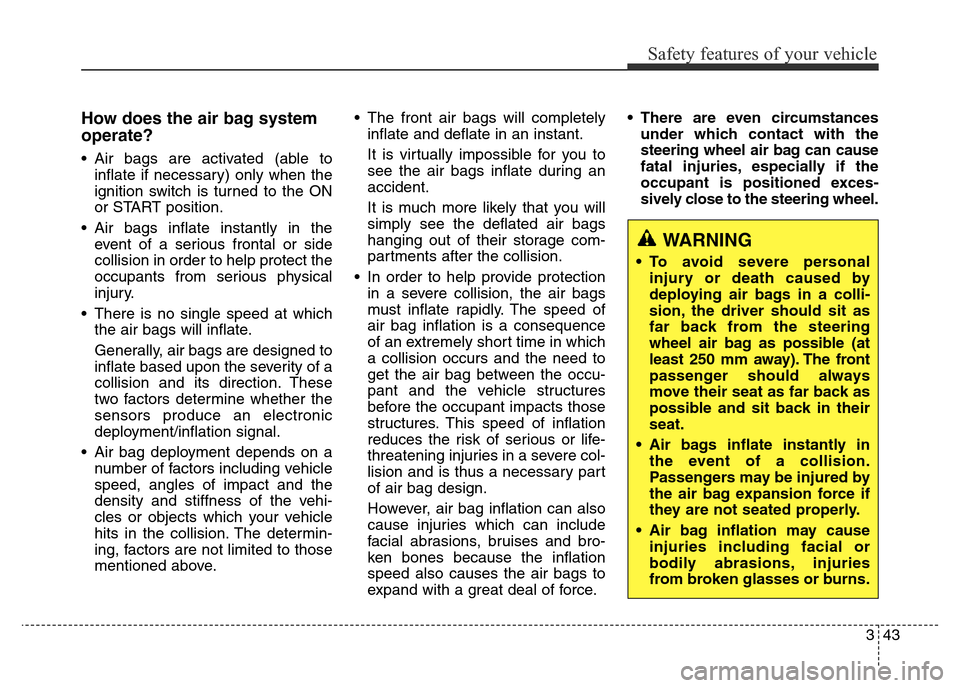
343
Safety features of your vehicle
How does the air bag system
operate?
• Air bags are activated (able to
inflate if necessary) only when the
ignition switch is turned to the ON
or START position.
• Air bags inflate instantly in the
event of a serious frontal or side
collision in order to help protect the
occupants from serious physical
injury.
• There is no single speed at which
the air bags will inflate.
Generally, air bags are designed to
inflate based upon the severity of a
collision and its direction. These
two factors determine whether the
sensors produce an electronic
deployment/inflation signal.
• Air bag deployment depends on a
number of factors including vehicle
speed, angles of impact and the
density and stiffness of the vehi-
cles or objects which your vehicle
hits in the collision. The determin-
ing, factors are not limited to those
mentioned above.• The front air bags will completely
inflate and deflate in an instant.
It is virtually impossible for you to
see the air bags inflate during an
accident.
It is much more likely that you will
simply see the deflated air bags
hanging out of their storage com-
partments after the collision.
• In order to help provide protection
in a severe collision, the air bags
must inflate rapidly. The speed of
air bag inflation is a consequence
of an extremely short time in which
a collision occurs and the need to
get the air bag between the occu-
pant and the vehicle structures
before the occupant impacts those
structures. This speed of inflation
reduces the risk of serious or life-
threatening injuries in a severe col-
lision and is thus a necessary part
of air bag design.
However, air bag inflation can also
cause injuries which can include
facial abrasions, bruises and bro-
ken bones because the inflation
speed also causes the air bags to
expand with a great deal of force.• There are even circumstances
under which contact with the
steering wheel air bag can cause
fatal injuries, especially if the
occupant is positioned exces-
sively close to the steering wheel.
WARNING
• To avoid severe personal
injury or death caused by
deploying air bags in a colli-
sion, the driver should sit as
far back from the steering
wheel air bag as possible (at
least 250 mm away). The front
passenger should always
move their seat as far back as
possible and sit back in their
seat.
• Air bags inflate instantly in
the event of a collision.
Passengers may be injured by
the air bag expansion force if
they are not seated properly.
• Air bag inflation may cause
injuries including facial or
bodily abrasions, injuries
from broken glasses or burns.
Page 64 of 498
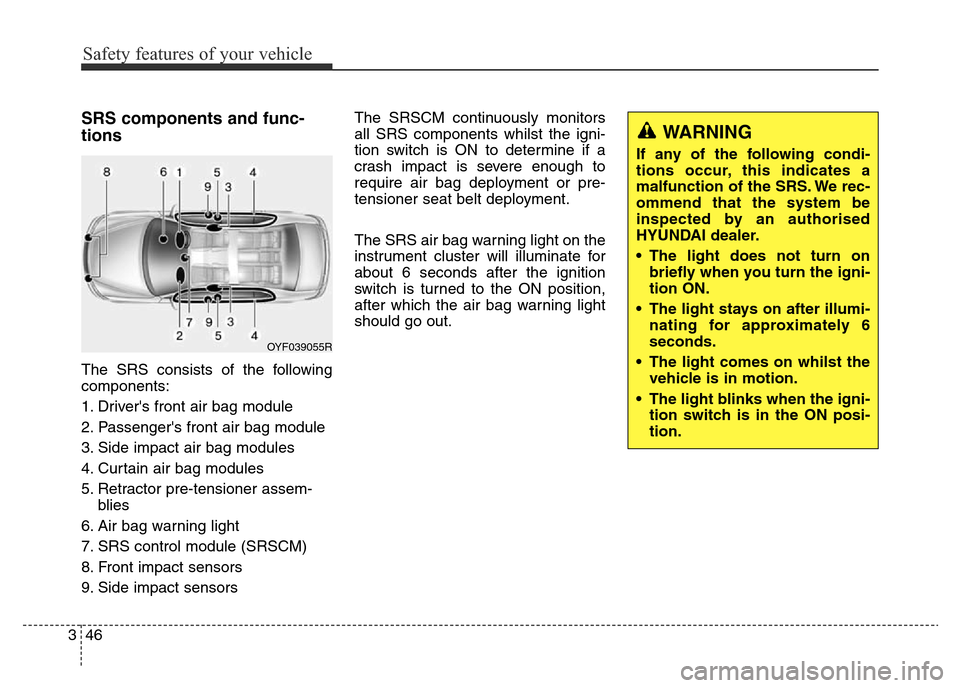
Safety features of your vehicle
46 3
SRS components and func-
tions
The SRS consists of the following
components:
1. Driver's front air bag module
2. Passenger's front air bag module
3. Side impact air bag modules
4. Curtain air bag modules
5. Retractor pre-tensioner assem-
blies
6. Air bag warning light
7. SRS control module (SRSCM)
8. Front impact sensors
9. Side impact sensorsThe SRSCM continuously monitors
all SRS components whilst the igni-
tion switch is ON to determine if a
crash impact is severe enough to
require air bag deployment or pre-
tensioner seat belt deployment.
The SRS air bag warning light on the
instrument cluster will illuminate for
about 6 seconds after the ignition
switch is turned to the ON position,
after which the air bag warning light
should go out.
OYF039055R
WARNING
If any of the following condi-
tions occur, this indicates a
malfunction of the SRS. We rec-
ommend that the system be
inspected by an authorised
HYUNDAI dealer.
• The light does not turn on
briefly when you turn the igni-
tion ON.
• The light stays on after illumi-
nating for approximately 6
seconds.
• The light comes on whilst the
vehicle is in motion.
• The light blinks when the igni-
tion switch is in the ON posi-
tion.
Page 71 of 498
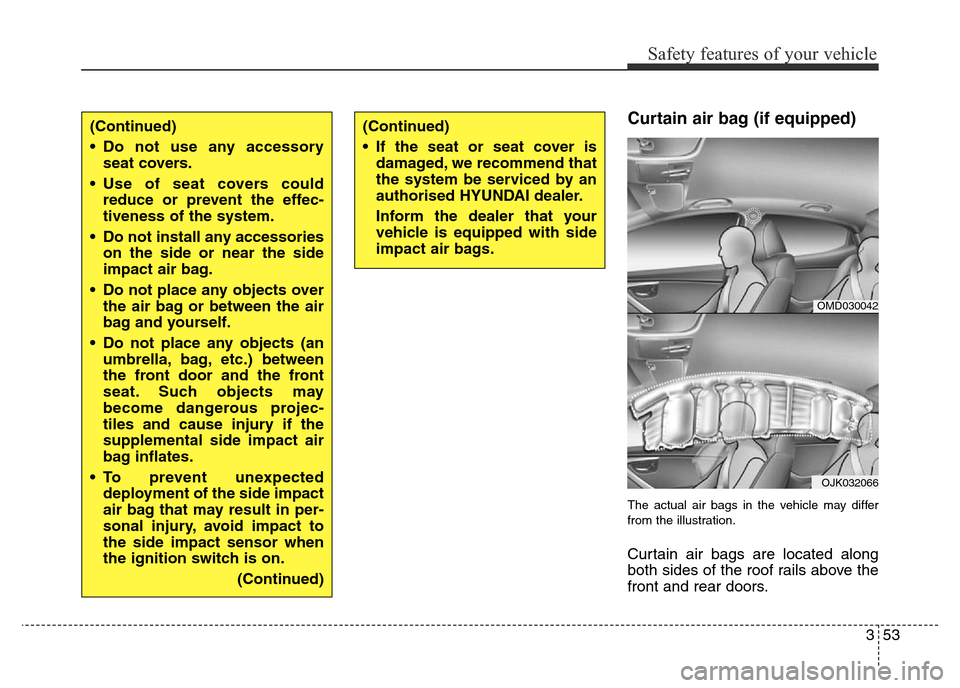
353
Safety features of your vehicle
Curtain air bag (if equipped)
The actual air bags in the vehicle may differ
from the illustration.
Curtain air bags are located along
both sides of the roof rails above the
front and rear doors.
(Continued)
• If the seat or seat cover is
damaged, we recommend that
the system be serviced by an
authorised HYUNDAI dealer.
Inform the dealer that your
vehicle is equipped with side
impact air bags.
OMD030042
OJK032066
(Continued)
• Do not use any accessory
seat covers.
• Use of seat covers could
reduce or prevent the effec-
tiveness of the system.
• Do not install any accessories
on the side or near the side
impact air bag.
• Do not place any objects over
the air bag or between the air
bag and yourself.
• Do not place any objects (an
umbrella, bag, etc.) between
the front door and the front
seat. Such objects may
become dangerous projec-
tiles and cause injury if the
supplemental side impact air
bag inflates.
• To prevent unexpected
deployment of the side impact
air bag that may result in per-
sonal injury, avoid impact to
the side impact sensor when
the ignition switch is on.
(Continued)
Page 73 of 498
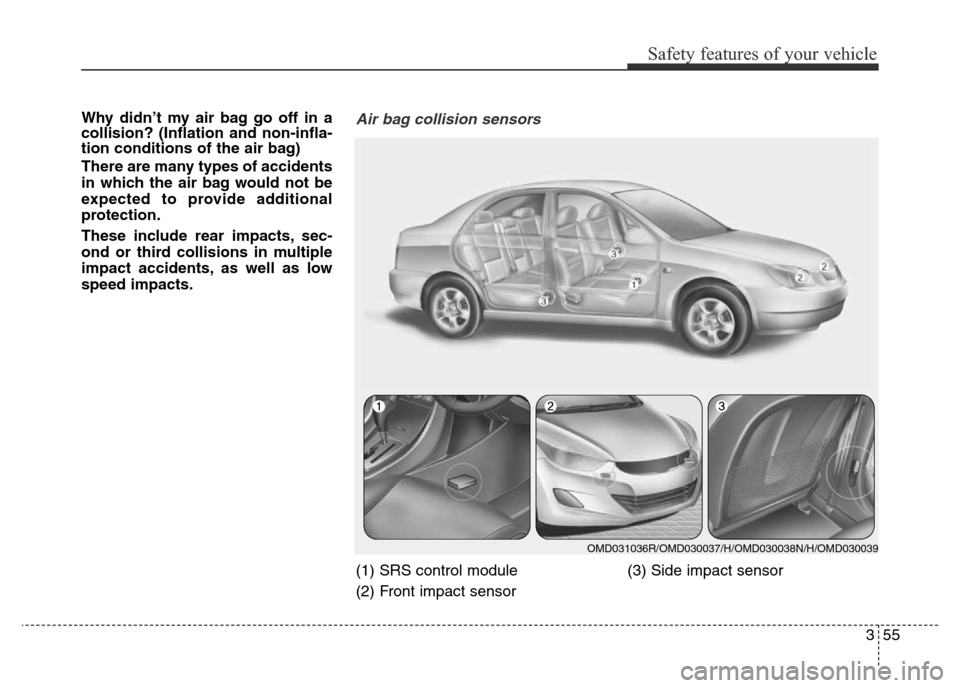
355
Safety features of your vehicle
Why didn’t my air bag go off in a
collision? (Inflation and non-infla-
tion conditions of the air bag)
There are many types of accidents
in which the air bag would not be
expected to provide additional
protection.
These include rear impacts, sec-
ond or third collisions in multiple
impact accidents, as well as low
speed impacts.
(1) SRS control module
(2) Front impact sensor(3) Side impact sensor
OMD031036R/OMD030037/H/OMD030038N/H/OMD030039
Air bag collision sensors
Page 74 of 498
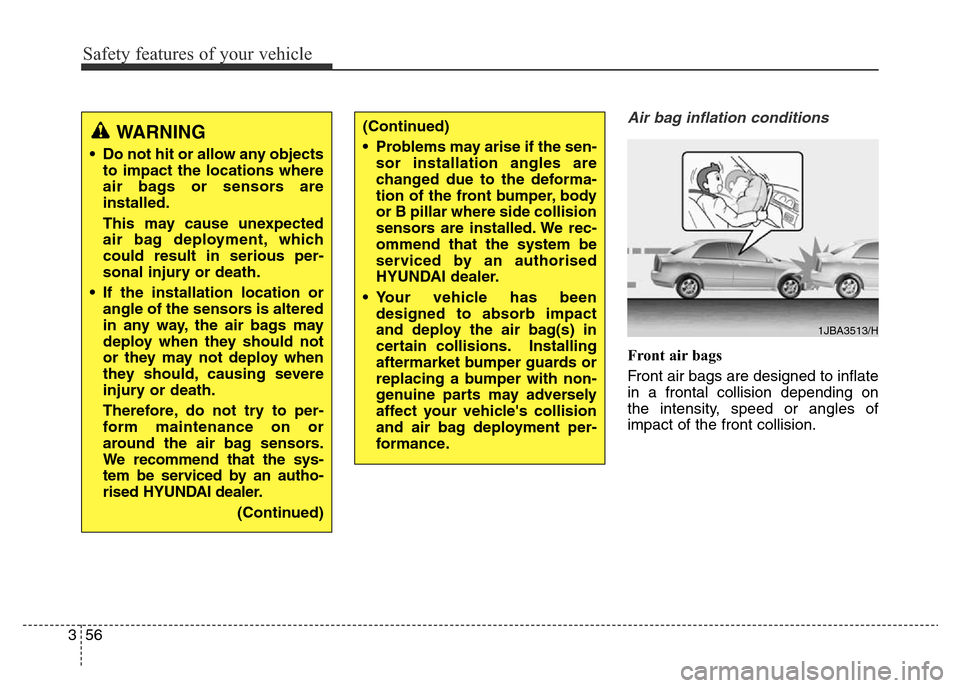
Safety features of your vehicle
56 3
Air bag inflation conditions
Front air bags
Front air bags are designed to inflate
in a frontal collision depending on
the intensity, speed or angles of
impact of the front collision.
WARNING
• Do not hit or allow any objects
to impact the locations where
air bags or sensors are
installed.
This may cause unexpected
air bag deployment, which
could result in serious per-
sonal injury or death.
• If the installation location or
angle of the sensors is altered
in any way, the air bags may
deploy when they should not
or they may not deploy when
they should, causing severe
injury or death.
Therefore, do not try to per-
form maintenance on or
around the air bag sensors.
We recommend that the sys-
tem be serviced by an autho-
rised HYUNDAI dealer.
(Continued)
(Continued)
• Problems may arise if the sen-
sor installation angles are
changed due to the deforma-
tion of the front bumper, body
or B pillar where side collision
sensors are installed. We rec-
ommend that the system be
serviced by an authorised
HYUNDAI dealer.
• Your vehicle has been
designed to absorb impact
and deploy the air bag(s) in
certain collisions. Installing
aftermarket bumper guards or
replacing a bumper with non-
genuine parts may adversely
affect your vehicle's collision
and air bag deployment per-
formance.
1JBA3513/H
Page 75 of 498
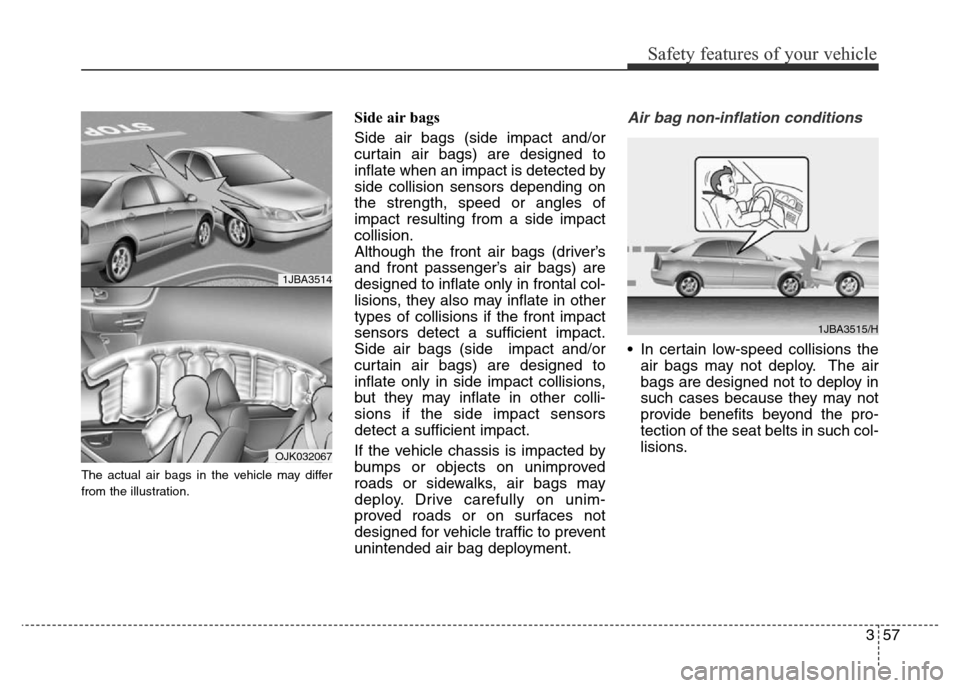
357
Safety features of your vehicle
The actual air bags in the vehicle may differ
from the illustration.
Side air bags
Side air bags (side impact and/or
curtain air bags) are designed to
inflate when an impact is detected by
side collision sensors depending on
the strength, speed or angles of
impact resulting from a side impact
collision.
Although the front air bags (driver’s
and front passenger’s air bags) are
designed to inflate only in frontal col-
lisions, they also may inflate in other
types of collisions if the front impact
sensors detect a sufficient impact.
Side air bags (side impact and/or
curtain air bags) are designed to
inflate only in side impact collisions,
but they may inflate in other colli-
sions if the side impact sensors
detect a sufficient impact.
If the vehicle chassis is impacted by
bumps or objects on unimproved
roads or sidewalks, air bags may
deploy. Drive carefully on unim-
proved roads or on surfaces not
designed for vehicle traffic to prevent
unintended air bag deployment.Air bag non-inflation conditions
• In certain low-speed collisions the
air bags may not deploy. The air
bags are designed not to deploy in
such cases because they may not
provide benefits beyond the pro-
tection of the seat belts in such col-
lisions.
1JBA3515/H
1JBA3514
OJK032067